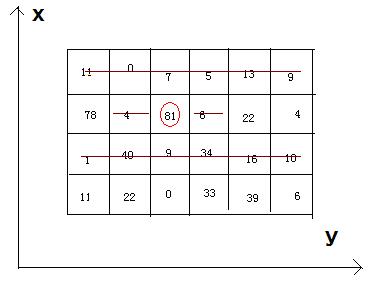HDU-2845 Beans(两次线性dp)
来源:互联网 发布:利驰数据 编辑:程序博客网 时间:2024/05/16 07:07
Beans
Time Limit: 2000/1000 MS (Java/Others) Memory Limit: 32768/32768 K (Java/Others)Total Submission(s): 5308 Accepted Submission(s): 2451
Problem Description
Bean-eating is an interesting game, everyone owns an M*N matrix, which is filled with different qualities beans. Meantime, there is only one bean in any 1*1 grid. Now you want to eat the beans and collect the qualities, but everyone must obey by the following rules: if you eat the bean at the coordinate(x, y), you can’t eat the beans anyway at the coordinates listed (if exiting): (x, y-1), (x, y+1), and the both rows whose abscissas are x-1 and x+1.

Now, how much qualities can you eat and then get ?

Now, how much qualities can you eat and then get ?
Input
There are a few cases. In each case, there are two integer M (row number) and N (column number). The next M lines each contain N integers, representing the qualities of the beans. We can make sure that the quality of bean isn't beyond 1000, and 1<=M*N<=200000.
Output
For each case, you just output the MAX qualities you can eat and then get.
Sample Input
4 611 0 7 5 13 978 4 81 6 22 41 40 9 34 16 1011 22 0 33 39 6
Sample Output
242
#include <bits/stdc++.h>using namespace std;int a[2001][2001], dp[2001][2], cnt[2001][2];int main(){int r, c;while(scanf("%d %d", &r, &c) != EOF){for(int i = 1; i <= r; ++i){for(int j = 1; j <= c; ++j){scanf("%d", &a[i][j]);}}dp[0][0] = dp[0][1] = 0;for(int i = 1; i <= r; ++i){cnt[0][0] = cnt[0][1] = 0;for(int j = 1; j <= c; ++j){cnt[j][0] = max(cnt[j - 1][0], cnt[j - 1][1]);cnt[j][1] = cnt[j - 1][0] + a[i][j];}dp[i][1] = dp[i - 1][0] + max(cnt[c][0], cnt[c][1]);dp[i][0] = max(dp[i - 1][0], dp[i - 1][1]);}printf("%d\n", max(dp[r][0], dp[r][1]));}}/*题意:一个网格,每个格子上有一个豆子,豆子有一个价值,如果拿走这个豆子,那么其所在行的上下行的豆子都不能拿,且其左右两个格子上的豆子也不能拿。问最多可以得到多少价值的豆子。思路:分两层线性dp,显然对于每一行,每一列格子上的豆子取不取的最大价值只和前一列取不取有关,所以可以有cnt[i][0]表示第i列不取时的最大价值,cnt[i][1]表示取的最大价值。现在转移方程可以是cnt[i][0] = max(cnt[i - 1][1], cnt[i - 1][0]), cnt[i][1] = cnt[i - 1][0] + a[i][j];这样可以计算出每一行有格子取时的最大价值。对于每一行,其取不取的最大价值只和前一行取不取有关,那么可以有dp[i][0] = max(dp[i - 1][1], dp[i - 1][0]); dp[i][1] = dp[i - 1][0] + w。w为第i行取的最大价值。*/阅读全文
0 0
- HDU-2845 Beans(两次线性dp)
- HDU 2845 Beans (两次线性dp)
- HDU 2845 Beans(dp+求两次最达不连续子序列和)
- hdu 2845 Beans(dp)
- hdu 2845 Beans(dp)
- HDU 2845 Beans (DP)
- HDU 2845 Beans(dp)
- HDU-2845 Beans(DP)
- HDU 2845 Beans(dp)
- HDU 2845 Beans (DP)
- HDU 2845 DP Beans
- hdu 2845 Beans (DP)
- HDU 2845 Beans DP
- hdu 2845 Beans dp
- HDU 2845 Beans DP -
- hdu 2845 Beans(二次DP)
- HDU-2845-Beans(简单DP)
- hdu 2845 Beans--二维DP
- 下拉刷新和上拉加载(pulltorefreshlistview)
- Caffe实践C++源码解读(2):走入Solver
- IntelliJ IDEA 15 创建maven项目 说明 创建Maven项目的方式:手工创建 好处:参考IntelliJ IDEA 14 创建maven项目二(此文章描述了用此方式创建Maven项目
- 深入理解java线程池—ThreadPoolExecutor
- java8 lambda 统计list中对象的重复次数
- HDU-2845 Beans(两次线性dp)
- springboot(十二):springboot如何测试打包部署
- mount: unknown filesystem type ‘ntfs’ 解决方法
- 【数据蒋堂】第30期:JOIN简化
- 关于逆向工程程序执行成功但是代码没有生成问题
- @DatetimeFormat与@JsonFormat
- js20171116
- 开发框架-Shiro-30分钟学会如何使用Shiro
- C/C++代码规范


